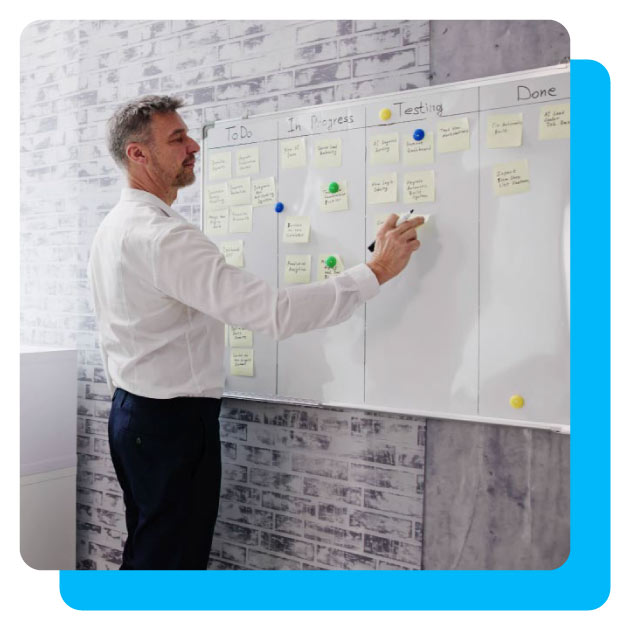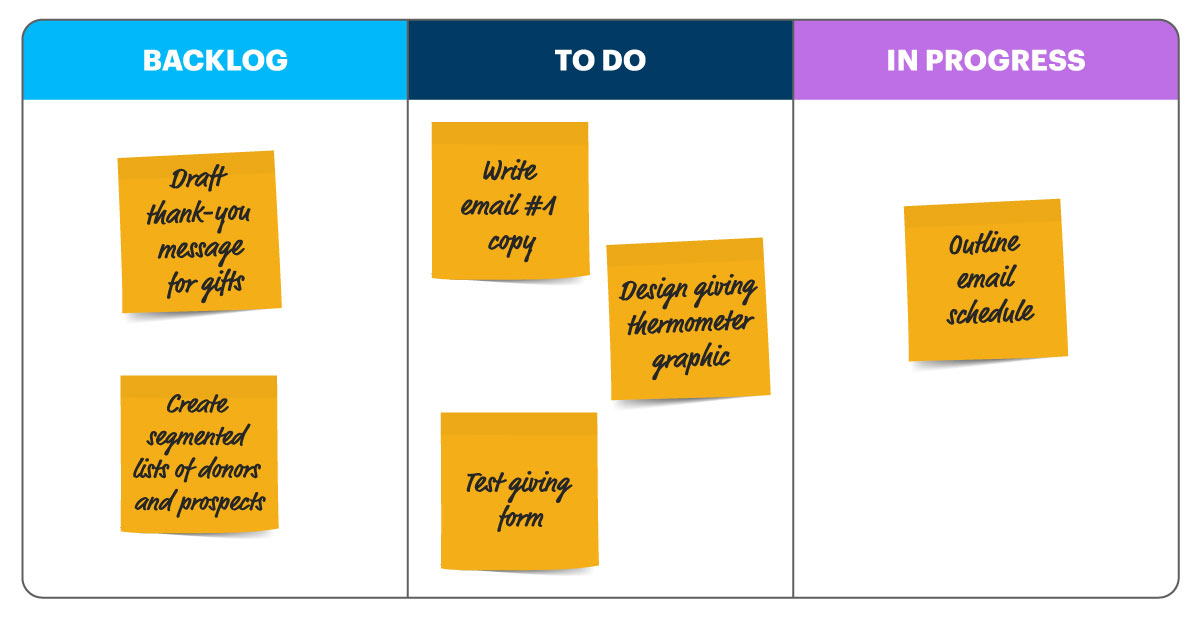Nonprofit Technology & Fundraising Blog
Subscribe to our mailing list

August 22, 2025 | Donor Data, Fundraising Operations, Planning
Agile fundraising has transformed how teams and businesses work in manufacturing, software development, and marketing, and now, nonprofits can increase their agility and productivity with Agile fundraising.
Whether you’re a development director leading the charge or an executive leader driving change, these proven strategies will help you build momentum and deliver results. This is your step-by-step roadmap to implementing agile fundraising, complete with templates, examples, and insider tips for using DonorPerfect to support your transformation.
Before we dive into the how-to, let’s talk about why implementing agile fundraising can be a career-defining opportunity—your moment to shine as a leader.
It demonstrates the skills nonprofit boards and senior leaders value most:
Remember, agile fundraising is not meant to overwhelm you. It’s simply an enhancement to your existing planning processes, helping you reduce last-minute scrambles, validate your direction, and improve your strategy in small bites.
It provides a structure for regular evaluation and adjustments as you go. You can start small by documenting your time savings, workflow improvements, and campaign metrics to discover what works for your team and what doesn’t.
Most change initiatives fail because they try to do too much too fast. Agile fundraising focuses on your reality—your team, your resources, and your timeline. It works because you build success incrementally, proving your team’s value at each step.
Start by reviewing campaign performance for some recent campaigns to establish baseline metrics. Volunteer to lead a small campaign or project where you can demonstrate agile fundraising principles.
Select something that’s:
A few examples include:
Pro tip: Present your pilot as risk mitigation: “Instead of betting everything on annual campaigns, we’ll test approaches in small batches and scale what works!”
This is where you start building your leadership reputation. Instead of simply following instructions, you’re now making data-driven decisions that improve outcomes.
Based on the success of your pilot:
Apply your learnings to a larger campaign:
Need to brush up on the terminology (e.g., “sprint planning”)? Check out our introduction to agile fundraising for definitions and examples!

Breaking down work is the foundation of getting things done in agile fundraising. It transforms a big, overwhelming project into a clear, manageable sequence of tasks your team can act on.
This process, often called grooming, scoping, or shaping, helps nonprofit teams take a goal (like “run our fall appeal” or “launch a recurring giving program”) and convert it into a list of discrete, actionable deliverables. By doing this, your team can estimate how long each task will take, assign ownership, and begin working in a focused, coordinated way.
From there, you break down those components into smaller chunks of work, or “tickets.” Each ticket should represent a single task or deliverable, like “pull list of LYBUNTs,” or “secure a quote for the appeal letter.”
Example: Imagine your team is planning your year-end fundraising campaign. Instead of treating the entire campaign as one giant to-do, you’d break it into smaller deliverables:

Some tickets may take 30 minutes; others, like list building or content writing, may span multiple hours or require collaboration with other colleagues. Once broken down and estimated, these tasks are added to your board or placed in the backlog, ready for execution.
Breaking down work also fosters a culture of accountability, shared ownership, and trust. Everyone knows what to do, how big the task is, and what success looks like. For nonprofits juggling limited time and resources, this clarity can be the difference between a chaotic scramble and a high-performing, well-executed campaign.
A visual management tool, also known as a Kanban board, is crucial for operating as an agile team. You can use whatever format works for you: a digital board, a spreadsheet, paper sticky notes, or a whiteboard. Set up columns for each stage of project planning and execution, and individual cards or tickets for each unit of work that has to be created.
Example 1: Create a board with 3 columns
Make individual work items like “write email 1” and “design email 1” and “create a list for email 1”, and “send email 1”. Move the tickets across the board from left to right as they advance through the process. Estimate the time to complete each task and track the expected hours to complete each ticket vs. the actual time it takes. The more you track, the better you will get at estimating tasks.
Example 2: Create a board with the stages of production
In this example, your individual tickets would be a bit more general, like “Email 1,” which would pass across the board through each stage of content, design, and deployment.
There is no empirically right or wrong way to set up your board; you have to make it work for your team’s capacity and level of collaboration required among various colleagues and partners. The concept is to pass work items across the stages of development until they are complete. It is to be kept in the open, to show the status of work items at a glance, and continued progress moving tickets across the board to “done.”
Sprint planning is the cornerstone of a well-run agile fundraising team. It’s the moment when your team pauses, aligns, and commits to what you’ll accomplish in the next sprint. Rather than diving straight into execution, sprint planning gives you time to clarify priorities, break down work, assign ownership, and ensure everyone starts with confidence and clarity.
In a traditional nonprofit setting, planning often happens in annual calendars or monthly meetings. Sprint planning shifts this approach to a nimble model that adapts to real donor behavior, campaign needs, and team capacity.
The goal is to answer three key questions: 1) What is the goal of this sprint? 2) What work will help us achieve that goal? 3) Who will do what, and how long will it take?
Start with your list of tasks in the backlog. This includes anything from writing content to building reports or scheduling donor meetings. As a Development Director, your job is to prioritize the most important items to focus on based on fundraising goals and timelines.
Align on a set of clear objectives that you can complete within a sprint.
These goals make it possible to achieve meaningful and measurable progress each sprint.
Each major item is broken into smaller deliverables or “tickets” (e.g., “write email copy,” “export donor list,” “design social posts”). This step includes shaping the work—clarifying what “done” looks like and making the scope realistic for a sprint.
Team members estimate how long each ticket might take (in hours, story points, or a complexity scale like easy/medium/hard) and claim the ones they’ll work on. This ensures no one is overloaded and that the team’s commitments are grounded in actual capacity.
Once all tasks are scoped and assigned, the team reviews the plan one last time. If there’s too much work, some tickets move back to the backlog. If there’s extra time, you may pull in stretch goals.
Sprint planning organizes work and energizes the team. By starting each sprint with shared purpose and clear expectations, your fundraising efforts become more focused, intentional, and ultimately, more successful.
These quick check-ins—or “scrums” as they’re called in agile fundraising—keep the team aligned, productive, and proactive about what comes next. Whether daily or 2–3 times a week, keep them under 15 minutes as a focused status update and take away more nuanced discussions and deeper dives.
Each team member answers 3 questions: 1) What did I accomplish yesterday? 2) What will I work on today? 3) What’s blocking my progress?
Stand next to your Kanban board or open it on a shared screen. Move tasks as you talk. This visual sync helps spot duplicate work, catch miscommunications, and solve problems early.
At the end of each sprint, hold a meeting with your team (often called a “sprint review” or “sprint retro”) to reflect on the outcomes of the sprint’s workload. Show what was completed, look at the data, and share initial donor or stakeholder feedback.
For example, if a lapsed donor appeal didn’t perform well, the review might reveal a mismatch between the audience and message tone. That insight can go directly into the next sprint’s work.
Review the sprint:
Focus on how you worked as a team, examining the effectiveness of your execution:
Document 1–2 process changes or experiments to try immediately. Keep it practical and collaborative, and review your changes in a future retro to see if they made improvements.
Like any good fundraising system, agile works best when it’s repeatable and team-owned. When everyone participates regularly, the entire team becomes more aligned, less reactive, and more confident, and better teammates. Over time, these routines become second nature, and your team becomes more transparent, focused, and resilient with every sprint.
This transition starts with you becoming a champion of the agile fundraising and continues as your nonprofit builds lasting systems, habits, and shared knowledge that outlive any one project.
Take ownership of advancing agile thinking across your team and beyond:
Pro tip: You can also apply agile thinking to your annual planning process! Break down the annual development plan into quarterly themes, and use sprint planning principles to drive execution. Try treating your major campaigns or initiatives as a series of evolving sprints rather than fixed, inflexible projects.
In agile fundraising, the scrum master is a facilitator, coach, and protector of the process. Their job is to ensure the team stays focused, aligned, and unblocked as they move through sprints to complete fundraising tasks. They help the team adopt agile practices and keep things running smoothly, especially when juggling overlapping campaigns, multiple donor audiences, or cross-department collaboration.
The scrum master is particularly valuable in fundraising environments where priorities shift, such as a board member making a request, a matching gift opportunity arises, or a news event impacts your mission. Without structure, this kind of work can become chaotic. The scrum master brings order, agility, and clarity to the process.
The scrum master leads sprint planning sessions to help the team scope out what work can be completed in a 2-week window. They guide the conversation to break down large fundraising goals into achievable tasks (e.g., “Send year-end appeal” becomes “Write copy,” “Design envelope,” “Upload mailing list,” etc.). They ask the right questions to help the team stay focused on the outcomes of the work.
In every stand-up or check-in, the scrum master listens for what’s slowing the team down. Are we waiting on data from the database manager? Do we need sign-off from a stakeholder? The scrum master steps in to unblock these issues or coordinate help so progress continues.
Fundraising teams are often new to agile, and the scrum master teaches as they go. They explain how to break down work, use a Kanban board, estimate time, and hold productive retrospectives. They create psychological safety so team members feel comfortable asking questions or admitting blockers.
One of the most important but subtle responsibilities is shielding the team from distractions. The scrum master prevents random, off-sprint work from derailing planned priorities. If leadership drops a new request mid-sprint (“Can we add an extra GivingTuesday email?”), the scrum master assesses whether it truly belongs now or should go into the backlog for the next sprint.
After each sprint, the scrum master leads a retrospective: What went well? What was difficult? What should we change? These sessions streamline future sprints and build team resilience.
A skilled scrum master brings rhythm and responsiveness to the work. They ensure that planning a campaign, stewarding donors, or launching a new appeal happens in a manageable, transparent, and collaborative way.
Implementing agile fundraising is about becoming the kind of leader nonprofits need in an increasingly complex world.
Skills you’re developing:
The nonprofit sector needs innovative leaders who can adapt quickly. Fundraising is a blend of creativity, urgency, and relationship-building, all of which require structure without rigidity. By implementing agile practices, your team will experience less stress, improved productivity, and more success.
Operate like a high-performing organization while staying grounded in your mission!
Follow us on social!